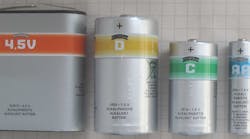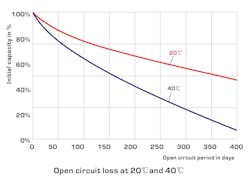This article is part of TechXchange: Why Low Iq is the Smart Thing to Do
Simply put, batteries power more and more electronic devices. Everyone is familiar with the panic that sets in when your cell phone is about to die. Cell-phone manufacturers go to great length to squeeze as much life as possible out of their batteries before you need to recharge them. Sometimes they throttle the performance, to the dismay of users. A better way to improve battery life is to use devices with low quiescent current, symbolized as Iq. These techniques will also serve to reduce battery size.
While it’s natural to think of portable devices as having batteries, lately many fixed electronic systems also use batteries. Examples include electronic meters for natural gas and water. Another is a smoke detector or CO2 sensor in your home. Numerous medical devices use batteries since they eliminate any shock hazard compared to a device that plugs into the wall. Batteries are also used for asset tracking in factories and warehouses. Making these batteries as small as possible makes your products less expensive, more convenient, and easier to recycle.
Another great application for low IQ devices is to eliminate that little plastic label on products you have to pull out of the battery compartment. Manufacturers put that tab in to disconnect the internal battery. If you can design the product with low IQ devices, the quiescent current might be less than the self-discharge rate of the battery (Fig. 1). That way, even if your product sits on a shelf for a year before selling, the battery won’t be discharged. Also, you won’t have confusion and customer dissatisfaction from the people who didn’t realize they have to pull that tab out before the product will function.
The advent of CMOS devices started the trend to low power consumption in semiconductors some 40 years ago. CMOS logic, like the venerable 4000-series, is used to this day for its low power consumption and radiation hardness. Soon, low-voltage CMOS logic appeared, as well as CMOS op amps and a CMOS version of the classic 555 timer chip.
CMOS amplifiers once had a reputation as being high in noise, but that’s often an outcome of design decisions. Making the transistors larger, and using just a bit more tail current in the first-stage differential transistor pair, can get CMOS amplifier noise down to manageable levels, while reducing battery size.
Process and Iq
While CMOS has low quiescent current, you should not really care about the process as much as the specifications. CMOS has low quiescent current, but the current draw will increase dramatically with switching transitions, perhaps making a CMOS chip use more power in normal operation. Another aspect of the process is how fast your chip starts working. If you save power by only enabling your circuit for a few moments, then taking measurements or doing some function, then it’s important to look at the startup time of the chip.
If you’re using chips with low Iq, it’s likely you will be designing your circuit with high impedance. Rather than using two 1-kΩ resistors in a voltage divider, you would use two 1-MΩ resistors. This will increase the noise of the divider, but you might be able to alleviate that with a filter capacitor. Thankfully, since the impedances are high, you don’t need a very large capacitor to provide significant filtering action.
Watch for Leakage
Another hassle with high-impedance circuits is stray leakage paths. Back in 2007, the city of Houston installed water meters that were supposed to have 10-year battery life. When the batteries started failing after a few years, analysis revealed that the meter was not designed for a high-humidity environment like south Texas. All of the low-Iq parts you use will be pointless if you let the battery discharge with surface leakage.
Another example of high-impedance headaches was cited by Eric Schlaepfer, now at Alphabet, but then working for Maxim Integrated. A customer complained that a very-low-Iq supervisor circuit was using over twice the current claimed in the datasheet. Schlaepfer reviewed the schematic and it looked good. He knew how unlikely an entire batch of parts could have failed testing and still been shipped. So, he asked the customer to send him a sample board with the part installed.
Schlaepfer knew one common mistake was leaving a scope probe connected while taking Iq measurements. Even a 1-MΩ probe will draw more current than many low-Iq chips will consume. That wasn’t the problem in this case; his initial measurement confirmed the customer’s complaint.
Schlaepfer then noted a fingerprint on the board in the area of the chip. Knowing skin oils may be salty and conductive, he carefully cleaned the board with denatured alcohol, also ensuring the area under the chip was cleaned thoroughly. As he expected, the part met its Iq spec easily. The customer was suitably embarrassed when Schlaepfer explained the problem. It turned out the customer’s assembly house had let employees handle the board and didn’t perform recommended flux cleaning. Even acid-free flux might cause measurable leakage in these high-impedance circuits.
Managing Your Iq
One way to evaluate your system’s Iq is to make a spreadsheet that tabulates the quiescent current of the devices you use (Fig. 2). This will add up the currents needed by various supplies in your system. Even when supplied by switching converters, you can then work backwards via the converter efficiency at a given load to estimate quiescent battery life for a given size. If you can get the quiescent current to be a small multiple of battery self-leakage, then you can consider eliminating shipping tabs or even an on/off switch.
Be sure to look at your entire circuit, since voltages put on resistive loads will also consume current. Here, you can use Spice to help figure out the current draws (Fig. 3). As always, be wary of the Spice models you use, because they may not accurately represent quiescent current. While it’s tempting to just look at the current coming out of the dc sources, you have to examine the currents all over the circuit to ensure they’re reasonable.
Help from the Industry
Intersil (now part of Renesas) was an early leader in CMOS circuitry. Its selection guides mention Iq since the company know it’s a critical parameter in battery-powered systems. Maxim was a spin-off of Intersil, which also stressed low-power CMOS circuits. Today, the firm has web resources and documents that help you understand the intricacies of low-Iq design. Its MAX17222 boost converter consumes 300 nA.
Texas Instruments has a broad portfolio of low-Iq chips (Fig. 4). While some manufacturers brag about linear regulators with several microamperes of quiescent current, the TI TPS7A02 specs 25 nA of Iq. Mike Beckman, TI’s vice president and general manager of linear power notes, “Boy, did it take a lot of work to get down to that low Iq.” He pointed out it would be easy if the regulator had poor transient response, but they wanted good handling of load transients with this chip.
Beckman noted another point regarding the achievement of such a low quiescent current. The low Iq wasn’t just a product of good design, although design expertise was critical. It was also necessary to have leading-edge semiconductor processes, as well as advanced testing facilities. While coy about the exact process, Beckman confided, “The part is on one of our newest process nodes.”
Conclusion
Using low- Iq parts and design methods, you can either extend battery life, or reduce the size of the battery, or perhaps achieve both of these desirable outcomes. The benefits accrue no matter if your product uses primary, that is, disposable batteries, or if you have rechargeable batteries. Longer battery life means more convenience for your users. Reducing battery size has ancillary benefits, since it will reduce the size of the product, as well as the size of the charging system, if any. By carefully watching every nanoamp, you can design your product for low Iq and reap the benefits.
Check out more articles in the TechXchange: Why Low Iq is the Smart Thing to Do




